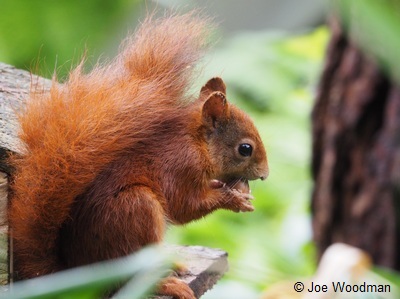By Joe Woodman, wildlife photographer and student at Magdalen College School.
Read blogs about the other mammals in the #UKMammalPoll and vote for your Favourite UK Mammal.

The red squirrel is perhaps one of the most iconic British mammals. These little red rodents can be seen hopping from branch to branch in pockets of select woodland across the UK, pausing only occasionally to gnaw on seeds, nuts, fruit and leaves. Their attractive appearance stems from tufted ears, a long bushy tail and a striking coat, which is composed of all shades of brown and red with distinctive white underparts. Having watched this mammal firsthand many a time, I cannot stress enough how beautiful the red squirrel is, both in appearance and manner.
I am lucky enough to visit the Isles of Scilly annually, where the red squirrel was introduced to the island of Tresco four years ago. The relatively high population density of these animals means that in certain areas of the island you can sit and watch them for hours, which is exactly what I do! It is this direct observation which caused me to fall in love with the species. Smaller than I first expected, their bodies are approximately 20 cm in length, but they make up for their size in their playful nature. Whether leaping among the branches, munching on hazelnuts or chasing off potential food thieves, something that always shows through is their liveliness. One behavioral trait that demonstrates this energetic nature is their mating chases. Several males will pursue a fertile female at once, producing amazing acrobatic displays. They will spiral around the tree trunks like clockwork toys fixed to the bark before suddenly leaping incredible distances into the forest canopy, springing from one branch to another tree over and over again.

The scientific name of Sciurus vulgaris is somewhat misleading at present; vulgaris – ‘common’ – is far from what the red squirrel is in the UK. There have been various population fluxes of the native species over time due to a variety of contributing factors, such as loss of habitat and even a brief period of culling between 1903 and 1933 to reduce bark-stripping damage to trees. However, the introduction of the grey squirrel in 1876 from North America was perhaps the tipping point that led to the demise of the reds. Grey squirrels are carriers of a virus known as Squirrel Pox; however they have developed immunity to the infection. When they were introduced to the UK, they passed this infection onto the reds with a catastrophic estimated 100% mortality rate amongst infected wild individuals. The combination of this alongside other ecological issues (direct competition with the greys as well as continuing loss of habitat) means that the national population of red squirrels is just 161,000, classifying it as Near Threatened in England, Wales and Northern Ireland.

We cannot allow the numbers to continue to decline, and with some conservation help we should be able to see these native reds enjoying our woodlands once more. Raising awareness of its demise must help to ensure that this spectacular creature remains part of our country’s rich and thriving wildlife – this regal red mammal deserves the crown!
Read blogs about the other mammals in the #UKMammalPoll and vote for your Favourite UK Mammal.

